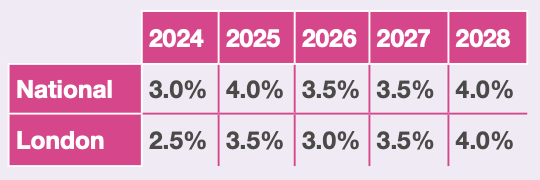Recent data reveals that construction vacancies have surged to their highest level in 18 months, leading to persistent labour shortages.
In the final quarter of 2024, labour costs rose by 1.6%, marking a 6.5% year-on-year increase.
Construction pay is now rising faster than in all but one other industry sector and is growing at its second highest rate since coming out of the pandemic.
Mace warns that higher energy prices and the rise in National Insurance and National Living Wage will also lead to upward cost pressure which has prompted the firm in its latest quarterly forecast to raise its tender price inflation forecast for this year.
Nationally, Mace’s updated forecast has risen from 3.5% to 4% for 2025, while 2026, 2027 and 2028 has been left unchanged. In London, the forecast is up from 3% to 3.5% in 2025 with 2026, 2027 and 2028 also remaining the same.
Tender price forecast

Although it remains an uncertain time, as output and the wider economy awaits the impact of policy changes that are expected to have a positive long-term impact, the report concludes that growth in construction in 2025 should comfortably beat that of 2024.
Oliver North, director of Cost and Commercial Management, Europe, Mace Consult said: “Driven by labour costs as vacancies continue to rise, Mace has increased its latest tender price forecast. However, with vacancies on the agenda to solve, this can be met in part with a focus on productivity, which remains low.
“The welcome recent government funding announcement, incorporating £600m to train 60,000 more construction workers, will be crucial in addressing shortages and supporting the industry’s growth also.
“However, economic and political uncertainties remain, and whilse the steps being made when it comes to planning, devolution and funding for the Building Safety Regulator will have a long-term impact, processes need to speed up to boost confidence, help secure pipelines and encourage investment”.

